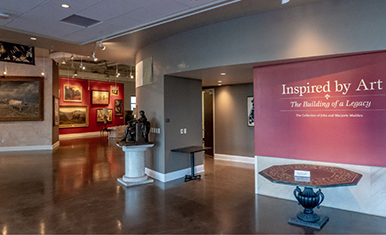CAHSS Psychology Professor Examines the Mind-Healing Potential of Labyrinths

DU Director of Spiritual Life Professor Sarah Pessin walking a labyrinth on campus in fall 2024.
Psychology Professor Danny McIntosh had been studying the psychology of religion and embodied emotions for decades and knew about the use of labyrinths as a tool for spiritual growth across multicultural, religious and global traditions. But when he started teaching his Advanced Seminar (ASEM) class on the Psychology of Religious and Spiritual Practices that included having students walk a labyrinth and reflect on their experiences, he wanted to dive deeper.
“Some students reported really positive, spiritually influential experiences and some did not,” he said. “Talking with them about the personal encounter with walking the labyrinth along with some of the questions they raised is part of what motivated me to propose this study.”
“The study” refers to a newly launched three-year, $500,000 grant from the Templeton World Charity Foundation to research the psychological and physiological effects of labyrinths in collaboration with Indiana University South Bend Chancellor’s Professor of Psychology and University of Denver Alumnus Kevin L. Ladd.
“Conducting this project with Professor McIntosh is particularly gratifying,” he said. “The labyrinth represents a metaphor for a pilgrimage or journey. In a very real way, Danny and I have shared that adventure, from the beginning of our mutual training with DU Professor Emeritus Bernard Spilka. Without Bernie’s inspiration and mentorship, this project and our collaboration would not have existed.”
Newly popular in promoting healing and wellness in health care, geriatric care, prison and educational settings, labyrinths are ancient and global designs that invite semi-structured moving meditations used for self-exploration and spiritual growth.
“There are lots of ways to engage with a labyrinth and many different designs and spiritual traditions,” McIntosh said. “But they all involve moving through a winding path that leads to a central destination, offer some kind of resolution or engagement in the middle and then involve a walk out along the same path. The idea is the person leaves somehow changed by what happened and experiences a reentry to life, to the world.”
Political Science and International Studies Student Frances Crowe walked a labyrinth in McIntosh’s ASEM class in spring quarter 2024.
“As I walked, I found that my thoughts would drift to the point that I’d forget where I was, where I had walked, and even if I had followed the path correctly,” she said.
“Crossing paths with someone else or getting to a trickier part in the pattern of the labyrinth would provide gentle reminders of what my only responsibility was while inside, putting one foot in front of the other. In this way, the labyrinth allowed my mind to wander, and me to feel and contemplate the thoughts weighing heavily on me, which was extremely cathartic.”
Labyrinths are also aesthetically pleasing and often in beautiful, serene settings. “The practice integrates movement, intention and focus, and is not constrained by time like a lot of sitting meditations but by engaging with space in a particular way,” McIntosh added. “The accessibility of labyrinths is one of the things that makes them potentially promising in reaching a wide range of people.”
The researchers have been building large, canvas labyrinths with drawn-on designs that they can take to various settings, McIntosh explained.
Department of Psychology undergraduate and graduate student research assistants will begin by collecting information from participants walking a labyrinth at the University Park United Methodist Church across the street from DU in winter 2025. They plan to repeat the research in a geriatric, assisted living or retirement community.
Student assistants will interview individuals engaged in these practices, collect physiological measurements (such as heart rate), process and analyze the diverse types of data and write and publish findings, according to McIntosh. Research students at Indiana University South Bend under Ladd’s guidance will gather similar data in their community.
Although credited with promoting personal and sometimes collective wellbeing, the benefits of working with labyrinths remain largely anecdotal. The study will gather scientific data about the effects of both walking labyrinths and tracing labyrinth designs with fingers across varied domestic and international populations, settings and spiritual traditions to better understand potential benefits and applied uses.
Initially, researchers will collaborate with partners in Vietnam and Indonesia and hope eventually to include broader international participation. “All countries have a variety of traditions, but Indonesia in particular has a large Muslim population and in Vietnam most of the people are affiliated with Buddhism which will enable us to compare data across those traditions,” McIntosh said.
Researchers plan to share findings gleaned from the study with scholars interested in meditation and with spiritual, wellness and health care practitioners working to support people with these practices.
In addition to using labyrinths in his ASEM class, in fall of 2024, McIntosh worked with DU Director of Spiritual Life Professor Sarah Pessin to construct a labyrinth on campus and engage students in walking it.
“Faculty from other departments and disciplines expressed their interest in using it,” McIntosh said. “It’s a practice that could be helpful in both educational and wellness settings on campus and certainly supportive of 4D Experiences aimed at integrating mind and body through both individual and community activity.”
McIntosh is grateful for the opportunity to work again with Ladd, whom he met while Ladd was a doctoral student in the DU psychology department in the 1990s. “He got his PhD at DU, had been researching labyrinths before me and is an excellent collaborator,” McIntosh said.
He’s excited about the ongoing collaboration with the Denver community the grant will entail. “This study isn’t about telling the community that labyrinths are good to have, it’s designed to really listen to the community and solicit their experiences to answer the questions we’re asking. We will be engaging with community members and practitioners in a two-way conversation from the beginning.”





